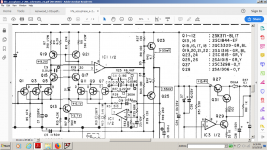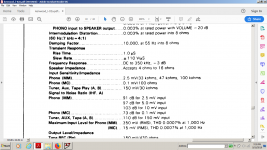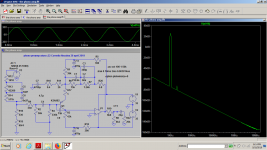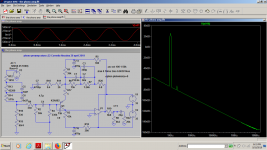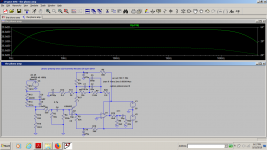Just had a quick view on it, too lazy, not so much interested by the subject.https://www.analogplanet.com/images/vinyl-dynamic-range.pdf
I think you understand these people better than me:
Does Vinyl Have Wider Dynamic Range Than CDs? Here's Some Math | Analog Planet
We should not forget the huge quantity of noise in the LP compared with the cd!
Several reasons why. First, if vinyl are just anecdotique nowadays for me, direct to disk are anecdotique in the vinyl world. So, I just care about analog tapes (with dolby A) dynamic, and I'm not afraid by the dynamic of my electronic stages.
See what I mean ?
As long as I can clearly hear the background noise of a vinyl copy of a CD and no clipping of the peaks of modulation, I am not afraid by my preamp rails voltages.
Notice: Apart the physical limitation of the engraving head, there is no theoretical limitation of the max modulation on a vinyl. We can only figure out by statistics. The pre-read head take care of the necessary space between two adjacent part of the groove, and it is just a limitation due to the duration of the music in one side (density) and decisions of the engineer in the mastering room.
No pre-read head on a direct to disk, you have to set the max level with care: chose your poison.
@Scott, my data points are from Tomlinson Holman's 'Dynamic Range Requirements of Phonographic Preamplifiers' (Audio, July 1977).
The minimum overload capability recommended in the paper is 100mV at 1kHz - so c. 33x or 30 dB for a typical 3mV output MM cart.

I think we're talking about two different things, I was referring most recently to the fixed gain pre-amp and digital RIAA issue. I presented a very hot reference recording with less than 6dB (1bit) difference in headroom needed when pre-emphasized or not. IMO the oft quoted 40dB is absurd and comes from simply looking at a frequency response curve and poor intuition.
On the phono overload issue I keep pointing out that an open-loop linear transconductance into the RIAA network as a load is not a passive RIAA as it is usually presented. It easily has 100mV or more at 1kHz. In the circuit I suggested I simply used a FET LTP so there was no "feedback" anywhere (entertainment value), using a CFP FET/bi-polar pair the linear input range can easily be a volt at all frequencies limited only by rails.
Holman claimed that a phono preamp should be capable of at least +22 db max output as i see on that plot of his. That doesn't mean that you can't listen to a preamp supplyed at +-15v with great results.Accuphase have proven this in E-206.But please be aware of the fact that the output of a phono preamp was designed to get into a subsonic filter, then a tone stack and after that a power amplifier , not a sound card ADC! Aiwa did a much simpler design with similar results for an mm setup at the same +-15v supply.... I just upgraded it at +-22v max power as i have the right op-amps to do it.
Just for the sake of confirming the data in the Kenwood -L02A service manual see some simulation i made with the input and outputs of a preamp using the universal op-amp model in the LTspice library and the K-L02 low impedance riaa network applied on a modified schematic version of aiwa c-22...yes the same aiwa c22 that i consider the best commercial preamp for the money ever made...
Only at a minimum supply voltage of +-35v i could get around -100db THD with the max input 950mv pk to pk or 350mv rms as specified in the kenwood service manual where they claim 0.0007thd, so their max input at 35.4 v supply for input and vas is correct... I'm not sure if you really need such performance, but if you can have it why not?The guys who listened that Kenwood said its a killer preamp, period.
The noise floor vs dynamics is always a problem with the usual gains , components and values used in phono preamps and cartridges.You can't get the dynamics ignoring the phono preamp noise itself so you need to take care of the feedback network impedance hence the power of the final stage in a phono preamp.
Do we need such overkill phono preamp? Not really, unless we need those 6db more than the max plot of HOLMAN... Yet i regret the fact that most of the good op-amps can't go higher than +-22v and just a few can accept +-25v supply, but then you have other problems due to noise level vs output and thermal regime imposed to an op-amp so you need a higher power amp too to get the extreme results imposed by a high end setup.
And a high end setup is made of a mm and and an mc phono preamp. That is something that people usually don't think about, the fact that most mc preamps are a front end stage to an mm phono preamp and mc carts aren't identical in dynamics and SNR with mm carts plus the pre-pre itself generate its own noise .
Hearing a faint sound into noise...that is a tough thing to analyze as its part of neurology and psychology . I was a NATO communication soldier and actually i was able to win a regional contest as i could hear the morse code signals embedded in a huge level of noise(active jamming). Now believe it or not i was really death compared to the rest of the participants, i really had hearing problems at the time , i still have some, but i was able to beat a quarter of the country just because i was well trained in hearing sounds..i was listening 5 hours of music daily for years and a lot of hours of real traffic in Morse code recorded on a very low quality cassette player using a magnet as erase head and no bias... It wasn't that most people wouldn't be able to understand Morse code the way i did, it wasn't that i had better hearing than them, on the contrary, it was that they weren't able to hear anything at all while i had poorer hearing than they had. After that contest , for a few months until i finished the civil service(it was mandatory) i was asked to confirm every traffic by the traffic leaders when they weren't sure what they heard...So it wasn't just luck...cause i could do it every time again and again... Well , I live i a mountain town and as other kids like me in our area we were going to fishing and foraging in deep mountains where we have wolves and bears so we had very good training at hearing all sorts of noises
Just for the sake of confirming the data in the Kenwood -L02A service manual see some simulation i made with the input and outputs of a preamp using the universal op-amp model in the LTspice library and the K-L02 low impedance riaa network applied on a modified schematic version of aiwa c-22...yes the same aiwa c22 that i consider the best commercial preamp for the money ever made...
Only at a minimum supply voltage of +-35v i could get around -100db THD with the max input 950mv pk to pk or 350mv rms as specified in the kenwood service manual where they claim 0.0007thd, so their max input at 35.4 v supply for input and vas is correct... I'm not sure if you really need such performance, but if you can have it why not?The guys who listened that Kenwood said its a killer preamp, period.
The noise floor vs dynamics is always a problem with the usual gains , components and values used in phono preamps and cartridges.You can't get the dynamics ignoring the phono preamp noise itself so you need to take care of the feedback network impedance hence the power of the final stage in a phono preamp.
Do we need such overkill phono preamp? Not really, unless we need those 6db more than the max plot of HOLMAN... Yet i regret the fact that most of the good op-amps can't go higher than +-22v and just a few can accept +-25v supply, but then you have other problems due to noise level vs output and thermal regime imposed to an op-amp so you need a higher power amp too to get the extreme results imposed by a high end setup.
And a high end setup is made of a mm and and an mc phono preamp. That is something that people usually don't think about, the fact that most mc preamps are a front end stage to an mm phono preamp and mc carts aren't identical in dynamics and SNR with mm carts plus the pre-pre itself generate its own noise .
Hearing a faint sound into noise...that is a tough thing to analyze as its part of neurology and psychology . I was a NATO communication soldier and actually i was able to win a regional contest as i could hear the morse code signals embedded in a huge level of noise(active jamming). Now believe it or not i was really death compared to the rest of the participants, i really had hearing problems at the time , i still have some, but i was able to beat a quarter of the country just because i was well trained in hearing sounds..i was listening 5 hours of music daily for years and a lot of hours of real traffic in Morse code recorded on a very low quality cassette player using a magnet as erase head and no bias... It wasn't that most people wouldn't be able to understand Morse code the way i did, it wasn't that i had better hearing than them, on the contrary, it was that they weren't able to hear anything at all while i had poorer hearing than they had. After that contest , for a few months until i finished the civil service(it was mandatory) i was asked to confirm every traffic by the traffic leaders when they weren't sure what they heard...So it wasn't just luck...cause i could do it every time again and again... Well , I live i a mountain town and as other kids like me in our area we were going to fishing and foraging in deep mountains where we have wolves and bears so we had very good training at hearing all sorts of noises
Attachments
Last edited:
We are talking about audio here. What is the max frequency we can find in DAC clocks ?Grounding will work at lower frequencies, but not above 1GHz
Just a question: What remain of a 1GHz low signal leakage in an audio stage ? What can be the lower frequency of the IM he could produce with any audio signal (what we could hear ) ?
In revenge, inside the DAC, could-it (i do not pretend it does) have an influence on the jitters ?
And jitters on the audible results ?
Last edited:
I think your mind is too relaxed and asocial from cheap mushrooms. Or Kindergarten, senile? Any case this is not a psychiatry forum, FYI.I can't make my mind on who's the culprit...is it Lenz's law or Faraday's law or maybe Maxwell law?What do you think?
I think it's The Law!
Shame on OPS that you are not permanently banned yet.
We are talking about audio here. What is the max frequency we can find in DAC clocks ?
Just a question: What remain of a 1GHz low signal leakage in an audio stage ? What can be the lower frequency of the IM he could produce with any audio signal (what we could hear ) ?
In revenge, inside the DAC, could-it (i do not pretend it does) have an influence on the jitters ?
And jitters on the audible results ?
That’s a bullet point from your PDF, not a statement from me, just to clarify.
It can all be measured in the output. Which was the point of my first reply to Richard.
You are repeatedly insulting me . Please see your own business!
Now you are so sensitive... take a glass of water, it will pass.
Ok, you are right and I do not contest it.
Let me summarize.
I "insult" you on purpose and you "insult" others (me too) on fun. Is this your point, or what do you wanna tell us? That's your game?
My forum mate, you are wrong. I do not insult you. I am only expressing finding a scientific high probability for a given fact, by german or us (you name it your favourite) science.
Now, you prove me wrong!
and also....
I just measured a DAC which uses AKM brand and its audio output also contains a lot of energy above 20-22Khz.
I had shown this from a Mastering Recorder last year. But other thingies which have DAC in them... over-sampling et al.... does this. But, not all, The BenchMark 3 DAC is free from any such output (<-100dbv).
This signal runs thru an output IC opamp and is there all the time.
Zero = 1v.
THx-RNMarsh
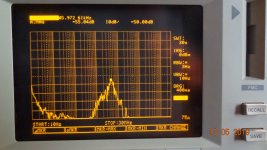
I just measured a DAC which uses AKM brand and its audio output also contains a lot of energy above 20-22Khz.
I had shown this from a Mastering Recorder last year. But other thingies which have DAC in them... over-sampling et al.... does this. But, not all, The BenchMark 3 DAC is free from any such output (<-100dbv).
This signal runs thru an output IC opamp and is there all the time.
Zero = 1v.
THx-RNMarsh

Last edited:
I think we're talking about two different things, I was referring most recently to the fixed gain pre-amp and digital RIAA issue. I presented a very hot reference recording with less than 6dB (1bit) difference in headroom needed when pre-emphasized or not. IMO the oft quoted 40dB is absurd and comes from simply looking at a frequency response curve and poor intuition.
On the phono overload issue I keep pointing out that an open-loop linear transconductance into the RIAA network as a load is not a passive RIAA as it is usually presented. It easily has 100mV or more at 1kHz. In the circuit I suggested I simply used a FET LTP so there was no "feedback" anywhere (entertainment value), using a CFP FET/bi-polar pair the linear input range can easily be a volt at all frequencies limited only by rails.
Ok - we were talking different things.
Re the OL margin - 40 dB is absurd. 20-30 dB is IMV a good place to aim for given the numbers I posted earlier. Again, this for a standard analog pre. The peak velocities measured in the Holman paper were at 2.7 kHz and 7 kHz - so not up at 20 k where there is little music energy.
I’ll have to look at the passive RIAA thing again - I don’t use that approach because IMV there are too many trade offs.
I read the article as wilful nonsense.
Just for the record I'll add



What remain of a 1GHz low signal leakage in an audio stage ?
DECT wireless phone base stations can cause problems in LME49720, and others in that family. Shows up as some spurs in an FFT. What is it, something like 2GHz? Spurs go away if the base station is unplugged from its power source. Mostly likely explanation seems to be demodulation in semiconductor junctions inside the opamp chip that then causes bias level shifting.
They really weren't. This thread has made you paranoid. I question some data and I am agressive and defensive. What is the world coming to?@billshurv no point in continuing the discussion with you. Your posts were aggressive and defensive. Not for the first time this week I may add.
What is the world coming to?
EDIT:
+1 for scottjoplin
Reading some text no one can hear tone of voice, read facial expression, other body language...
The limitations I'm afraid of text only communication. I've thought many a time here it's best to have small ego, thick skin and short memory.
Yes Short memory is the best asset you could have not only on this forum, but generally in life...
Last edited:
I concur. Phono preamp overload margin has a limited value. My phono stage was recently considered as "the best phono preamp we heard in integrated amplifier" and has "only" 20 dB overload margin. I can make 30 dB but then sonic performance will be degraded.I question some data and I am aggressive and defensive. What is the world coming to?
- Status
- Not open for further replies.
- Home
- Member Areas
- The Lounge
- John Curl's Blowtorch preamplifier part III
